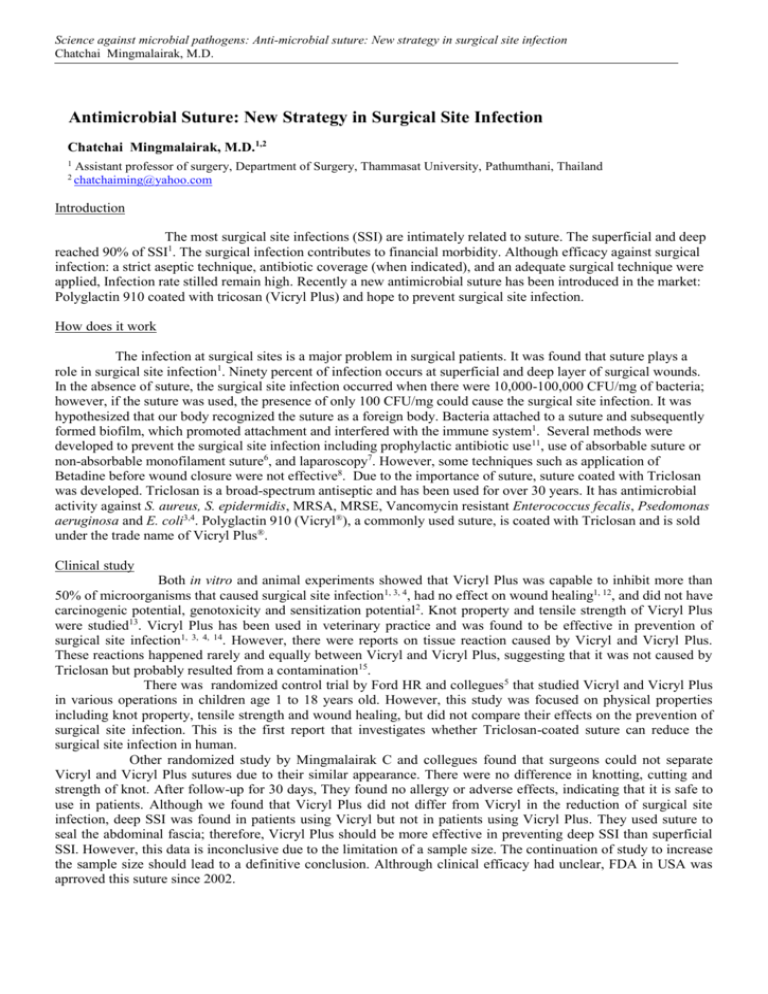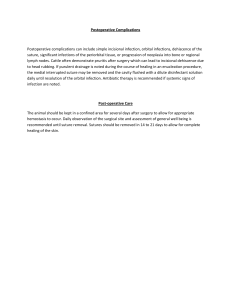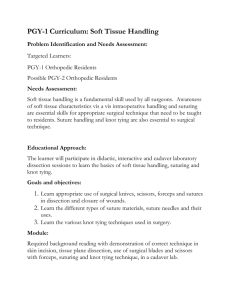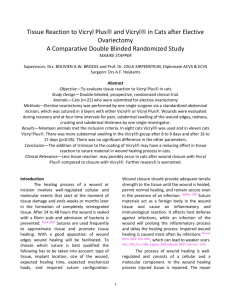Template for abstracts - Formatex Research Center
advertisement

Science against microbial pathogens: Anti-microbial suture: New strategy in surgical site infection Chatchai Mingmalairak, M.D. Antimicrobial Suture: New Strategy in Surgical Site Infection Chatchai Mingmalairak, M.D.1,2 1 2 Assistant professor of surgery, Department of Surgery, Thammasat University, Pathumthani, Thailand chatchaiming@yahoo.com Introduction The most surgical site infections (SSI) are intimately related to suture. The superficial and deep reached 90% of SSI1. The surgical infection contributes to financial morbidity. Although efficacy against surgical infection: a strict aseptic technique, antibiotic coverage (when indicated), and an adequate surgical technique were applied, Infection rate stilled remain high. Recently a new antimicrobial suture has been introduced in the market: Polyglactin 910 coated with tricosan (Vicryl Plus) and hope to prevent surgical site infection. How does it work The infection at surgical sites is a major problem in surgical patients. It was found that suture plays a role in surgical site infection1. Ninety percent of infection occurs at superficial and deep layer of surgical wounds. In the absence of suture, the surgical site infection occurred when there were 10,000-100,000 CFU/mg of bacteria; however, if the suture was used, the presence of only 100 CFU/mg could cause the surgical site infection. It was hypothesized that our body recognized the suture as a foreign body. Bacteria attached to a suture and subsequently formed biofilm, which promoted attachment and interfered with the immune system1. Several methods were developed to prevent the surgical site infection including prophylactic antibiotic use11, use of absorbable suture or non-absorbable monofilament suture6, and laparoscopy7. However, some techniques such as application of Betadine before wound closure were not effective8. Due to the importance of suture, suture coated with Triclosan was developed. Triclosan is a broad-spectrum antiseptic and has been used for over 30 years. It has antimicrobial activity against S. aureus, S. epidermidis, MRSA, MRSE, Vancomycin resistant Enterococcus fecalis, Psedomonas aeruginosa and E. coli3,4. Polyglactin 910 (Vicryl®), a commonly used suture, is coated with Triclosan and is sold under the trade name of Vicryl Plus®. Clinical study Both in vitro and animal experiments showed that Vicryl Plus was capable to inhibit more than 50% of microorganisms that caused surgical site infection1, 3, 4, had no effect on wound healing1, 12, and did not have carcinogenic potential, genotoxicity and sensitization potential2. Knot property and tensile strength of Vicryl Plus were studied13. Vicryl Plus has been used in veterinary practice and was found to be effective in prevention of surgical site infection1, 3, 4, 14. However, there were reports on tissue reaction caused by Vicryl and Vicryl Plus. These reactions happened rarely and equally between Vicryl and Vicryl Plus, suggesting that it was not caused by Triclosan but probably resulted from a contamination15. There was randomized control trial by Ford HR and collegues5 that studied Vicryl and Vicryl Plus in various operations in children age 1 to 18 years old. However, this study was focused on physical properties including knot property, tensile strength and wound healing, but did not compare their effects on the prevention of surgical site infection. This is the first report that investigates whether Triclosan-coated suture can reduce the surgical site infection in human. Other randomized study by Mingmalairak C and collegues found that surgeons could not separate Vicryl and Vicryl Plus sutures due to their similar appearance. There were no difference in knotting, cutting and strength of knot. After follow-up for 30 days, They found no allergy or adverse effects, indicating that it is safe to use in patients. Although we found that Vicryl Plus did not differ from Vicryl in the reduction of surgical site infection, deep SSI was found in patients using Vicryl but not in patients using Vicryl Plus. They used suture to seal the abdominal fascia; therefore, Vicryl Plus should be more effective in preventing deep SSI than superficial SSI. However, this data is inconclusive due to the limitation of a sample size. The continuation of study to increase the sample size should lead to a definitive conclusion. Althrough clinical efficacy had unclear, FDA in USA was aprroved this suture since 2002. Science against microbial pathogens: communicating current research and technological advances A. Méndez-Vilas (Ed.) Conclusion Antimicrobial suture was safe and satisfy in surgical practice. Surgical site infection was seemed too comparable between antimicrobial suture and traditional suture. Complete randomized study was required for final conclusion Keywords :Vicryl Plus, Triclosan, Surgical site infection, Antimicrobial suture, Antibacterial suture, Polyglactin 910 coated with tricosan






